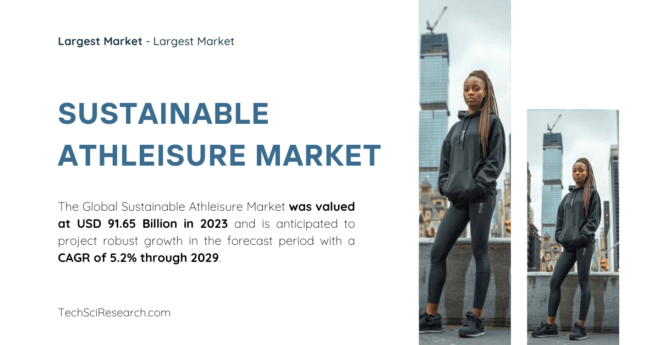
The global sustainable athleisure market, valued at USD 91.65 billion in 2023, is expected to grow at a CAGR of 5.2% during the forecast period of 2025-2029. This dynamic sector reflects a convergence of consumer preferences for sustainability, environmental awareness, and industry innovation.
As sustainability becomes a central theme in consumer lifestyles, athleisure brands are leveraging eco-friendly materials, ethical manufacturing, and versatile designs to cater to growing demand.
Sustainable Athleisure Market Dynamics
Environmental Sustainability as a Core Driver
The rising awareness of environmental sustainability among consumers has significantly impacted the athleisure market. Shoppers increasingly opt for products that align with their values, emphasizing reduced ecological footprints and ethical production practices.
Use of Eco-Friendly Materials
- Brands are adopting materials such as:
- Organic cotton: Cultivated without synthetic chemicals.
- Recycled polyester: Reduces reliance on virgin plastics.
- Regenerated fabrics: Promotes circular fashion.
- This shift extends to adopting low-impact dyes, biodegradable packaging, and innovative fabric technologies.
Browse over xx market data Figures spread through xx Pages and an in-depth TOC on the “Global Sustainable Athleisure Market” @ https://www.techsciresearch.com/report/sustainable-athleisure-market/23043.html
Ethical Manufacturing
Sustainable athleisure brands focus on:
- Fair labor practices: Ensuring workers’ rights and safe working conditions.
- Energy-efficient processes: Reducing emissions and water usage during production.
Health and Wellness Trends
The rising emphasis on health and wellness is another critical driver for the sustainable athleisure market. The versatility of athleisure aligns seamlessly with an active lifestyle, which has become a priority for modern consumers.
Multifunctional Appeal
Athleisure’s unique selling proposition lies in its ability to:
- Transition from workouts to casual wear, reflecting an active yet stylish lifestyle.
- Cater to comfort and performance, especially for health-conscious individuals.
This consumer preference for multi-functional apparel has transformed athleisure into a daily essential, further driving market growth.
Celebrity Endorsements and Brand Collaborations
Celebrity endorsements and strategic collaborations between traditional sportswear brands and sustainable fashion labels are accelerating market adoption.
Influential Endorsements
- Celebrities advocating for sustainable living enhance the visibility of eco-friendly athleisure.
- Their influence motivates consumers to make conscious purchasing decisions.
Strategic Collaborations
- Partnerships combine performance expertise with eco-conscious designs, leading to unique, limited-edition collections.
- These collaborations often draw attention to innovative practices and sustainability goals within the industry.
Key Challenges in the Sustainable Athleisure Market
Cost Implications
The high costs associated with:
- Procuring sustainable materials.
- Implementing ethical manufacturing practices.
Some consumers remain hesitant to pay premium prices, posing a barrier to widespread adoption.
Limited Material Availability
- Sustainable options like organic cotton and recycled fabrics are often scarce or expensive.
- This necessitates investment in research and development for alternative materials.
Consumer Education
- Many consumers are unaware of the benefits of sustainable athleisure.
- Brands need effective marketing strategies to:
- Highlight value propositions.
- Encourage behavioral change towards eco-friendly consumption.
Fast Fashion and Trend Cycles
- Rapid trend changes in the fashion industry challenge sustainability efforts.
- Athleisure brands must balance staying on-trend while maintaining ethical standards.
E-Commerce: A Catalyst for Growth
The rising popularity of online sales channels plays a pivotal role in the market’s growth.
Accessibility and Convenience
- Online platforms provide consumers with easy access to sustainable athleisure options.
- Shoppers can explore diverse offerings from global and niche brands.
Targeting Eco-Conscious Shoppers
- Digital platforms allow for personalized marketing, targeting environmentally conscious individuals seeking both style and functionality.
Sustainable Athleisure Market Competitive Landscape
Leading Companies in the Sustainable Athleisure Market
Prominent players driving innovation and growth in the sustainable athleisure market include:
- Adidas AG
- Nike, Inc.
- PUMA SE
- Patagonia, Inc.
- Hanesbrands Inc.
- Under Armour, Inc.
- Wear Pact, LLC
- Vuori, Inc.
- Pangaia Materials Science Limited
- Eileen Fisher, Inc.
Key Strategies
- Investment in sustainable technologies.
- Collaboration with non-profit organizations to promote ethical practices.
- Expanding product lines to cater to diverse consumer needs.
Regional Analysis of Sustainable Athleisure Market
North America
- Dominant market share is driven by robust consumer demand for eco-friendly products.
- Presence of leading athleisure brands and well-established e-commerce networks.
Europe
- Emphasis on sustainability regulations supports market growth.
- High consumer awareness of environmental issues drives adoption.
Asia-Pacific
- Growing focus on health and wellness.
- The increasing middle-class population with disposable income favors athleisure purchases.
Download Free Sample Report @ https://www.techsciresearch.com/sample-report.aspx?cid=23043
Customers can also request 10% free customization on this report.
Sustainable Athleisure Market Future Opportunities
Innovation in Materials
- Exploring biodegradable fibers and lab-grown fabrics to expand eco-friendly options.
Expansion into Emerging Markets
- Tapping into untapped regions like Africa and South America, where demand for affordable sustainable athleisure is rising.
Enhanced Marketing and Consumer Engagement
- Leveraging social media and influencer partnerships to educate consumers.
- Emphasizing storytelling to highlight the impact of sustainable practices.
Conclusion
The global sustainable athleisure market represents a transformative shift in consumer behavior, where fashion meets environmental consciousness. With key drivers like rising health awareness, eco-friendly preferences, and celebrity influence, the market is poised for significant growth.
Addressing challenges such as cost barriers, material availability, and consumer education will be critical for sustained expansion.
As brands innovate and adapt to evolving trends, the intersection of sustainability and athleisure highlights a promising future for the industry, paving the way for mindful consumption and sustainable living.
You may also read:
Suitcase and Briefcase Market Report: Key Trends, Demand, and 5.79% Growth Forecast to {2029}
Sun Lounger Market {2029} Size to Surge with 5.7% CAGR, USD 2.95 Billion
Surface Water Sports Equipment Market to Reach USD [53.1 Billion] by {2029} with a CAGR of [9.4%]
